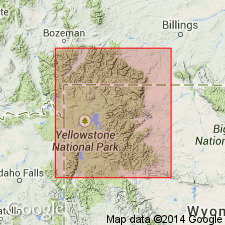
- Usage in publication:
-
- Washburn Group*
- Modifications:
-
- Named
- Dominant lithology:
-
- Volcanics
- AAPG geologic province:
-
- Yellowstone province
- Montana folded belt
- Bighorn basin
Summary:
Named for Washburn Range (its type area), Yellowstone National Park, WY (fig. 1) in Yellowstone province. Rocks of Washburn make up much of the northern Absaroka Range (Bighorn basin), Washburn and Gallatin (Montana folded belt province) Ranges. Consists mostly of lavas and related volcaniclastic strata composed of hornblende and pyroxene andesite, lesser amounts of basaltic lavas and rhyodacite ash-flow tuffs. Is more than 3,000 ft thick near vent areas in the Absaroka, Washburn, and Gallatin Ranges. Most of the rocks were erupted from separate but nearly contemporaneously active centers. Light-colored rocks were called early acid breccia or acid andesitic breccia and flows. Dark-colored units were called early basic breccia or basic andesite breccia. Divided into Cathedral Cliffs and Lamar River at Specimen Ridge and northeastern and eastern parts of Park, Sepulcher Formation at Sepulcher Mountain and at Bighorn Peak, and Golmeyer Creek and Hyalite Peak Volcanics in northeastern Gallatin Range. Is of early and middle Eocene age.
Source: GNU records (USGS DDS-6; Denver GNULEX).
For more information, please contact Nancy Stamm, Geologic Names Committee Secretary.
Asterisk (*) indicates published by U.S. Geological Survey authors.
"No current usage" (†) implies that a name has been abandoned or has fallen into disuse. Former usage and, if known, replacement name given in parentheses ( ).
Slash (/) indicates name conflicts with nomenclatural guidelines (CSN, 1933; ACSN, 1961, 1970; NACSN, 1983, 2005, 2021). May be explained within brackets ([ ]).

